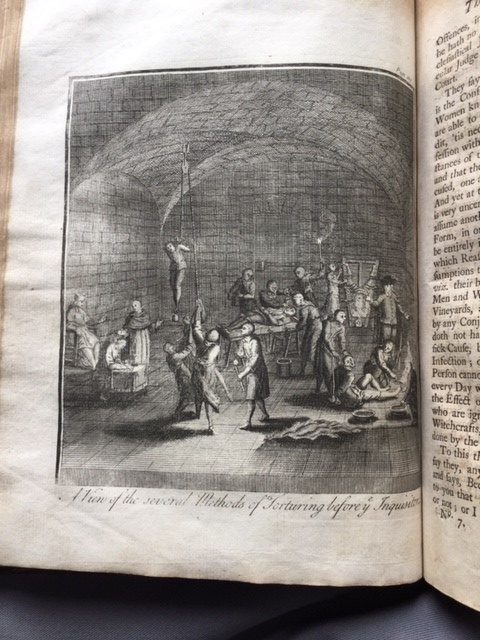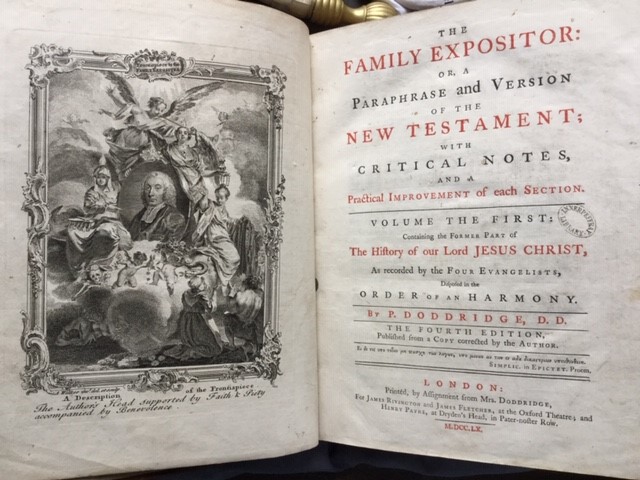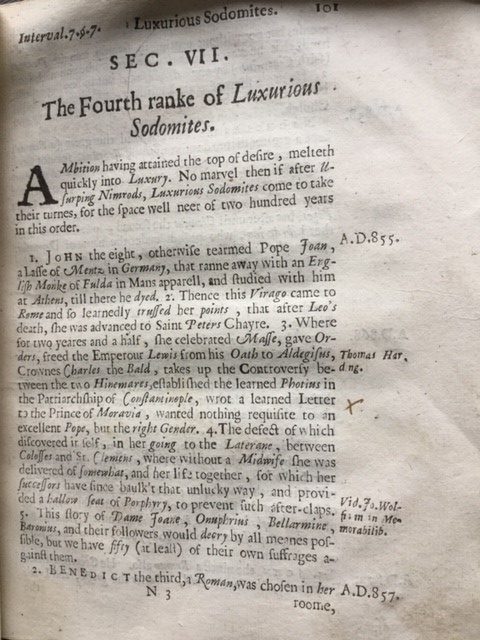Tour of the Tops – Episode 1 “Initial Inquiries Lead to Historical Hilarity”
Welcome to a new series of blogs that will be appearing throughout the year to interest, intrigue and, one hopes, entertain followers of the goings-on of Innerpeffray Library. The theme is a general one, but should deliver up something to pique everyone’s interest at some point. For those of you lucky enough to have visited the Library, you will have noticed that the shelves really do go from floor to ceiling and, as a result, there are some shelves that really do not get the attention that they perhaps deserve. This series aims to remedy this injustice by dragging out the ladder and going for a quick Tour of the Tops to see what gems there are awaiting true recognition! I will note, this is very much based on what grabbed my attention whilst atop a ladder, so apologies to those who love sermons, or meaty Latin texts – I left those where there were! So without further ado, let’s get climbing and see what’s lying in wait.
The first book to grab my attention was “A Complete History of the Inquisition in Portugal, Spain, Italy, the East and West-Indies…”, written by the Reverend Mr. Baker, M.A. in 1736. What really helped this book’s case was, of course, the promise of “several Copper Plates, representing their Manner of Punishment, etc. etc. etc.”! So I had a quick read through the book and found a rather interesting account of an interrogation of a chap by the name of Louis Ramé. As you may have guessed from his name, he was neither Portuguese, nor Spanish, nor Italian, but French. Again, this intrigued me as France was a mostly Catholic country, but on reading his account, it seems that he was a French Protestant from the Southwest and he had been picked up by the Inquisition in Mexico, then part of the Spanish Empire. The book provides a gripping account of the interrogations (one does have to wonder HOW Mr. Ramé managed to remember it all verbatim years later…) and some interesting facts are thrown up. He reveals that he has 18 (!!!) siblings and most seem to still be alive, although he’s less sure how many cousins he has; when asked how many children his aunt and uncle have, he responds “five or six daughters”. Reading through the full story, it turns out that he was stuck in prisons for over nine years before being eventually taken to Spain and released. All in all, a most fascinating book on the Inquisition with plenty on offer to terrify the average British reader… One does have to wonder, however, how much was truthful and how much had been exaggerated to heighten fears of what would happen to the country were a Catholic power ever to conquer it. The book was taken out 14 times according to the Borrowers’ Register – all between 1804 and 1863. One chap, a John Dougall of Muthill, clearly enjoyed it a lot as he took it out four times!

The next book to catch my eye entertained me immensely once I opened it to the frontispiece. Welcome to the catchily titled “Family Expositor” a “Paraphrase and Version of the New Testament with Critical Notes and a Practical Improvement of each Section” (my italics). Yes, the author, the most wonderfully named P. Doddridge, D.D., has decided that the work of the disciples could be improved and so decides to tell his readers exactly how they could be. He clearly had a high opinion of himself, as the opposing page has a picture of “The Author’s Head supported by Faith and Piety, accompanied by Benevolence”, as you can see below…

I took down the first volume (of six!) and began to read. His improvements prove to not be quite what I expected. I had hoped that it would be his attempts at trying to rework the Bible, but instead they seem to be more along the lines of ways to improve the reader’s approach to life. A good example of this is in the “Improvement” from the Feeding of the Five Thousand. He focuses her on churchmen, saying that “Ministers of the Gospel have it in their Power to assist Men in their Temporal, as well as Spiritual Necessities” (very much HIS italics!). His style is very preachy at times – another Improvement begins “Alas, how prone are our foolish Souls to relish and regard the Things of Men, rather than those of GOD!”. I may have been highly amused by how time has worn away the strength and meaning of a lot of what was written here, but it is, in truth a fascinating insight into the kind of book that people were reading at this time. In fact, it must have been quite popular at one point, because whilst I was reading through it, a fellow volunteer noticed that we have a second full set of the “Family Expositor” about six shelves down from where I had found him! Clearly a most popular chap indeed – his works were borrowed over 30 times between 1776 and 1895 with a number of repeat borrowers, including a certain Mrs. Stalker, wife of Thomas Stalker whose story was introduced in a previous blog post! In fact, possibly playing on the fact that it was aimed at families, there were six different women borrowing the book out of twenty individual borrowers.
The final book in this first post is easily my favourite of the three, and a perfect example of the title betraying little of the wonders within the book! Welcome to “An Easy and Compendious Introduction For Reading all sorts of Histories: Contrived in a more facile way than heretofore hath been published”. This was the fourth edition of Mathias Prideaux’s work and was printed in 1664. I am quite the history fan and historical history books always fascinate me, so I started to flick through the pages and, well, came across this:

Yes, read it again, it does indeed say:
So, in utter bafflement as to how a history book could be discussing this topic, I found that this was a chapter title and it turned out to be about none other than the Popes! Yes, for those not in the know, the “Luxurious Sodomites” came just after a sequence of “Usurping Nimrods” and began with the infamous Pope John VIII, also known as Pope Joan! Historians now doubt the existence of a female Pope, but it was a well-told story by Protestant writers trying to discredit the Catholic Church, so it is unsurprising that she gets a mention in here, especially given the obvious bias that this author has against the Catholic Church! Not being the greatest expert on the papacy, I then turned to read about one Pope whose actions had quite the impact on English history; namely Clement VII, who denied Henry VIII a divorce from Catherine of Aragon and led to the creation of the Church of England. I was not disappointed by the description of Clement “crossing our King Henry the eighth and deluding him in the Divorce from his Brothers [sic] Wife, Queen Katherine, he lost his supremacy here in England, and for his lewd life otherwise, made his See infamous.” But… My eye then glanced down the page onto the description of his successor… “Paul the third, who prostituted his sister Julia Farnesia to Alexander the sixth that he might be made Cardinall, committed incest with his own daughter Constantia, and poysoned her husband Bosius Sforsia, to enjoy her the more freely”. Goodness me! Obviously, a huge pinch of salt should be taken here – the author has a very clear bias against the papacy and is clearly repeating any rumour he can find about them, but still! The accusations being levelled almost beggar belief. I intend to return to this book later as there were sections on other areas of history later on, so watch out for more coming from this book in future articles. Just remember the title of this book: “An Easy and Compendious Introduction For Reading all sorts of Histories”. I don’t know about you, good reader, but I’ve not read THAT sort of history before! Fascinatingly, this book appears to have never been borrowed – so maybe this book has been on a top shelf for most of its lifetime in the Library!

And thus, we come to the end of the first ‘episode’ of our Tour of the Tops. I hope you’ve found it intriguing so far and that it’s piqued your interest to maybe have a look up there the next time that you are in the Library. The next episode will talk about Scotland’s most remote island, hint at perhaps an early attempt at Instagram in 17th Century India and reveal some utterly delightful cityscapes! RS
